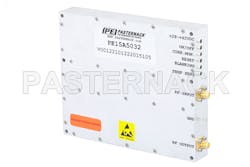Note on GaN HEMT Amplifier Soft Compression
Class III-V semiconductors, such as gallium arsenide (GaAs) and gallium nitride (GaN) have become commonplace solid state technologies for low noise amplifiers and high power amplifiers from frequencies ranging from several hundred megahertz to over 100 GHz. For high power applications, GaN high electron mobility devices (HEMTs) are supplanting GaAs metal-semiconductor field-effect transistor (MESFET) amplifiers, as there are several key advantages that GaN HEMTs exhibit over GaAs MESFETs for high power applications. This includes a trends for GaN HEMTs to exhibit higher voltage breakdown, higher temperature operation, better mean-time-between-failure (MTBF), lower parasitics at higher frequencies, and greater efficiency at higher power. These considerations are significant for many applications that are cost and reliability sensitive.
However, when looking at comparisons between comparable GaAs MESFET and GaN HEMT amplifiers, it is readily observable that the GaAs MESFET’s exhibit more linear performance than GaN HEMTs. Particularly noticeable is the soft compression curve that GaN HEMTs demonstrate. This results in relatively poorer third-order distortion levels for GaN HEMTs. In certain amplifier configurations and applications, such as with Class A amplifiers, this is not desirable.
However, for some amplifier configurations, modulation, and with assistive technologies this apparent linearity challenge is readily overcome and highly efficient and linear power amplifiers can be realized. Mainly, using Class AB amplifier configurations and using predistortion techniques can greatly enhance a GaN HEMT amplifiers linear performance, as the low parasitics typical of GaN HEMTs make these techniques easier to realize.
There is some evidence that the soft compression typical of GaN HEMTs is confined to continuous wave (CW) operation, i.e. if the AM/AM measurements are made under static conditions. However, GaN HEMTs may experience gain expansion when AM/AM measurements are made under dynamic conditions, such as with modulated stimulus. It is suggested that these devices soft compression is actually an artifact generated by GaN HEMT’s electron trap-related phenomena, and is only demonstrated during unrealistic CW AM/AM characterization. There have been studies that show that under dynamic stimuli, that GaN HEMTs demonstrate a clear Class C output with highly nonlinear gain expansion followed by strong gain compression.
GaN Power Amplifier Applications & Use Cases
• High power and wide band communications
• High efficiency for high peak to average power ratio (PAPR) communications
• Wideband radar, such as active electronically scanned arrays (AESAs)
• Phased array transmit/receive modules
• 4G and 5G cellular telecommunications
• Satcom, both in space and ground stations
• Unmanned aerial vehicle (UAV) communications
• High temperature and high reliability (Hi-Rel) applications
Learn more about Pasternack’s line of GaN Power Amplifiers:
